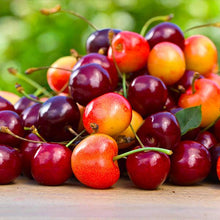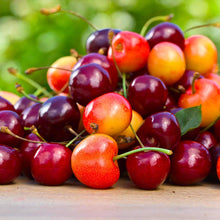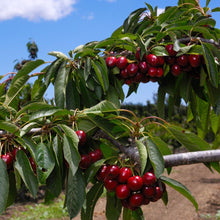Two Different Types Of Cherries On A Single Tree
Don’t settle for one type of cherry when you can grow two different types of cherries on a single tree. Each cherry will surprise you with a rush of distinct and unique sweet and tangy flavors.
From spring into the summer you’ll be harvesting tons of sweet and sour cherries with firm skin and juicy flesh for a refreshing snack during hot days. You won’t have to rush to the store for expensive cherries because you’ll have a huge supply on hand that are perfect for baking pies and tarts.
Get tons of fruit without taking up much yard space. With one, compact cherry Surprise 2 in 1 Tree you’ll get the same amount of fruit as people with two different cherry trees do, only you will have more room in your yard for your family to relax and play in.
Enjoy beautiful cherry blossoms every spring as they erupt all over your tree. The blossoms will fill the landscape with breathtaking color and a sweet floral fragrance.
Every Cherry Surprise 2 in 1 Tree consists of two different cherry varieties that have been carefully hand grafted on to a healthy, mature rootstock. This process ensures that each tree is healthy, as well as pest and disease resistant.
Once you plant your worry free Cherry Surprise 2 in 1 Tree you’ll have buckets of delicious cherries before you know it.
While we can’t guarantee the exact types of cherries that you will receive on this tree, you will receive two of the varieties listed:
Royal Ann Cherry
Lapins Cherry
Bing Cherry
Black Tartarian Cherry
Stella Cherry
Planting & Care
The multi-grafted cherry is a unique tree that gives you several varieties of cherries with just one tree, this multiple graft cherry (Prunus avium sp.) is a pleasure to watch bloom and fruit. Growing in USDA zones 5-8, they can tolerate cold down to -10 degrees and do not require a lot of chill hours, so they can also grow in the south and still produce fruit. This semi-dwarf fruit tree does not take up a lot of space in your landscape while still providing you with multiple varieties of cherries. Only reaching 15-20 feet tall and 10 feet wide, it’s a great way to have several varieties of cherry without having to have an orchard to do so. The multi-grafted cherry does not require a pollinator as the different grafts naturally cross pollinate with one another!
Location: Choose a sunny spot that will give your cherry tree a minimum of 6 hours of direct sunlight per day. Although it will thrive in almost any kind of soil, avoid locations where the soil will remain soggy for prolonged lengths of time.
Planting Instructions:
1) Dig a hole that is as deep as the root ball and three times as wide.
2) Place the roots in the hole and fill the hole about half-way with soil, tamp to remove air pockets then fill the hole completely.
3) Water to secure the tree and remove any additional air pockets in the soil.
4) Add more soil if necessary after settling.
5) Spread a layer of mulch over the soil around your cherry tree to help keep the soil moist, encourage healthy growth and protect your tree against competing growth.
Watering: During the growing season, if your tree receives at least an inch of rain every 10 days then no additional irrigation is necessary. If the season is hot and dry then you may need to provide some additional water. The best way to water is by using a slow trickling garden hose left at the base of the tree. This will allow the water to penetrate the soil more deeply and prevent it from running off over the soil surface. Make sure the ground is fully moisturized all around the root system. Mulching will greatly assist in maintaining soil moisture.
Pruning: A year after planting your cherry tree, prune your tree in the late to end of winter while dormant. Shape the tree to encourage horizontal branch growth with space between branches. Prune once a year as necessary to remove weak, drooping branches. These are usually poor fruit bearing branches and removing them will encourage positive air flow and healthy growth. Also make sure light can penetrate the center of the canopy.
Fertilization: Good, nutrient rich soil should only require the addition of nitrogen. Fertilize in the spring and midsummer using nitrogen fertilizer twice annually applying 2 weeks after planting and 4 weeks after the first application. Use a complete fertilizer such as 10-10-10 and apply at the rate of 0.05 pounds of actual nitrogen per dose. Fertilizer application ratios vary upon the formulation so be sure to follow package directions. When applying, be sure fertilizer is 6 to 8 inches away from the trunk around the tree to prevent the roots from burning. Organic fertilizers such as manure or blood meal are highly discouraged as their nitrogen levels cannot be measured. Keep in mind that cherry trees require high levels of nitrogen early in the season and lower levels during the late summer.
Pests: Cherry trees can be susceptible to brown rot. The best prevention for this problem is proper pruning to provide good air circulation. Be sure there is ample room between branches. Remove any infected blossoms, fruit or leaves and inspect your tree continuously to catch any early signs of the disease. To spot brown rot, look for brown, soggy flowers or mummified looking fruit on your tree. For control once the disease is recognized, use a sulfur spray 4 times: when flower buds are pink, when flowers are open, right after petal fall, and 2 weeks after petal fall.





